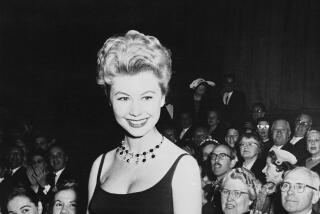All the Talents, All the Appetites : THE HOUSE OF BARRYMORE <i> By Margot Peters (Knopf: $29.95; 640 pp., illustrated) </i>
- Share via
In the very last days of her life, Ethel Barrymore, at 79, was weak but still receiving visits from old friends in her bedroom, banked with pink carnations. One, distressed at her frailty and not sure she was even listening, made conversation: “ ‘And you know,’ he concluded, ‘Bette Davis and Gary Merrill are touring in “The World of Carl Sandburg,” reading his poetry.’ The famous blue Barrymore eyes flew open.
“ ‘Thanks for the warning,’ she whispered.”
Quintessential Ethel. That’s the woman so prodigiously revealed by Margot Peters in “The House of Barrymore,” a masterful, pungent, essential evocation of the last comets of a great theatrical line. This is biography with the grip of a Le Carre novel; the most transporting saga and the most horrifying cautionary tale.
Mingling the lines of theater legends, the Drews and the Barrymores--Lionel, Ethel and John--possessed wit, the highest standards of taste and an insider’s view of the theater that was unsentimental and unsparing. Theater, silents, talkies, vaudeville, tent shows: You gave them your best. There’s a vivid anecdote here of Stella Adler glimpsing a tall, straight figure at midnight in Pennsylvania Station: Ethel Barrymore in her 60s, returning from an out-of-town performance, lugging her suitcases, all alone.
Acting aside, the Barrymores seemed, in one degree or another, to have all the talents--for painting, sketching, composing, and wickedly memorable conversation. Together, they also had all the appetites--for morphine, cocaine, alcohol, sex and the spotlight. Of the only film they made together, the overwrought “Rasputin and the Empress,” Peters documents a fiendishly difficult trio: “Jack on drink, Lionel on drugs, Ethel on her high horse.”
All three were touched by the family curse, a susceptibility to alcohol and drug addiction which claimed 11 of their clan from John Drew Sr. to Diana Barrymore. They responded to it with an iron will, or no will at all. Ethel, at 60, finally faced her alcoholism and stopped drinking, abruptly and forever. Lionel’s use of morphine had most likely begun in 1925, to ease arthritic pain aggravated by a venereal disease that “responded to treatment.” He could never stop. Jack’s drinking dulled not one of his fears, nor did it diminish his self-hatred. When Peters closes her almost unbearable account of his last years by reporting that “the long suicide of Jack Barrymore was at last accomplished,” the reader’s relief is as profound as his.
Peters is candid about these flaws, not sensationalistic; she simply documents them with the same eloquence she uses to illuminate the Barrymore magnetism onstage. She’s persuasive in suggesting that Lionel, Ethel’s “unlucky one,” may have been the better actor of the brothers, although what came indecently easily to Jack was a torture to Lionel. It was Lionel who disappeared uncannily into a character; for all his intelligence and passion, Jack remained Jack. Lionel’s real genius onstage is one of the book’s revelations, certainly to movie audiences. He made more than 200 films, and in the process disinterest replaced fervor, reducing Lionel’s acting--with few startling exceptions--to a collection of rumbling, crusty mannerisms.
Jack, the artist, the lover, who built aeries and “Alchemist’s Corners” to live in, was the trio’s lecherous Little Prince. Indecently handsome, his Promethean self-indulgences came from deeply rooted self-hatred. The spectacle of Jack burning out his talent is the book’s central tragedy; the wonder is that he lasted as long as he did.
Then there was Ethel, passionately interested in music, books, painting, politics, boxing, people. Ethel, the darling of society, who was, in truth, a working girl with two good dresses, one black, one white, when she conquered London, and not incidentally young Winston Churchill; Ethel, lured by her proximity to society into a disastrous marriage to a millionaire’s vacuous son. Called an “opalescent dream” at 16, she had found her style at 20 and reigned majestically as “First Lady of the American Theater” her life long. She would rather have been First Actress, but “Mrs. Patrick Campbell said that the greatest actresses have to have a bit of the gutter in them. Ethel never dipped a toe.”
Scrappy and remote with each other, at polar opposites politically, the Barrymores shared one thing in their reviews: the constant complaint that, Shakespeare aside, the First Family was too often abroad in inferior vehicles.
If they’d conspired from childhood to thwart biographers--and they very nearly did--Lionel, Ethel and Jack hardly could have done a better job of it. As Peters notes, Barrymore history is tangled, distorted, falsified and just plain missing. Peters notes it; she doesn’t whine about it, and she’s able to untangle everything but the facts about the death of the older of Lionel’s two daughters. Both girls died young, but not to pinpoint where or even when Mary died clearly rankles the scrupulous Peters.
Lionel came by his reticence honestly. Their maternal grandmother Mummum (accent on the second mum ), the steelly actress-manager Mrs. John Drew, was the most profound influence on the three, and her rule was that one’s deepest feelings were never to be disclosed.
Mummum’s nature denied her grandchildren warmth, approval and love and mortally wounded their ability to give it themselves. Firstborn Lionel, shy and self-deprecating, was secretive to the point of pathology. Ethel, so full of emotion onstage, seemed to have tragically little offstage: Her three children loved but feared her; she had a thousand friends but no intimates. Mercurial Jack, who so feared his own beautiful, feminine side, lived in snarling combat with each of his three wives and destructively neglectful of his daughter, Diana.
To ride herd on three billowing Barrymore personalities at once requires the talents of Sherlock Holmes, Sigmund Freud and Mary Poppins. Or Margot Peters. Even as it chronicles waste and loss, her book shares the qualities of the noblest Barrymore: It has heart, wit, dedication and verve.
More to Read
The biggest entertainment stories
Get our big stories about Hollywood, film, television, music, arts, culture and more right in your inbox as soon as they publish.
You may occasionally receive promotional content from the Los Angeles Times.










